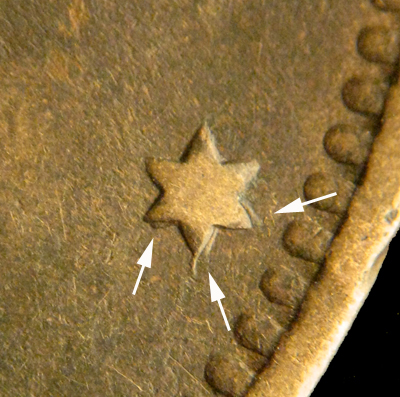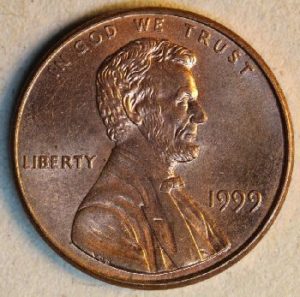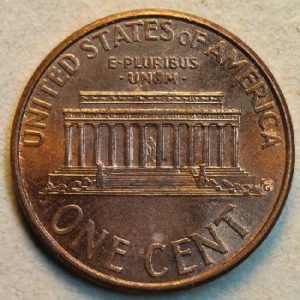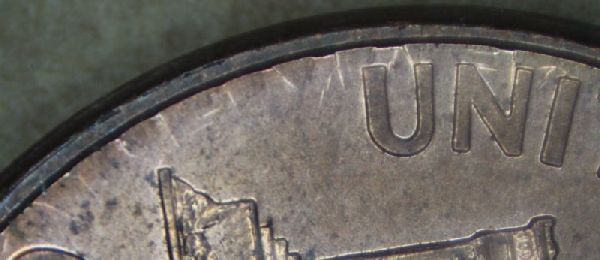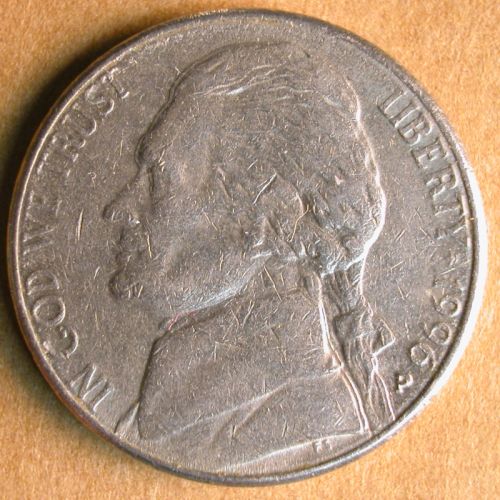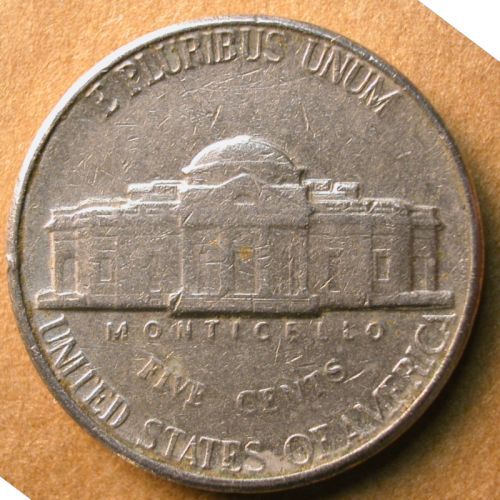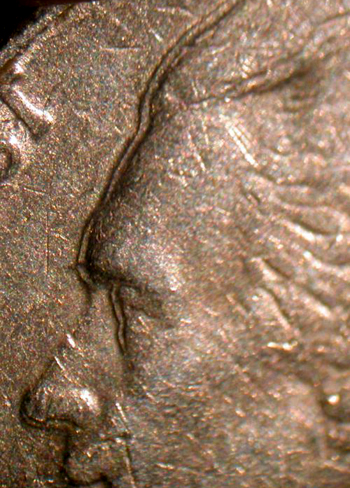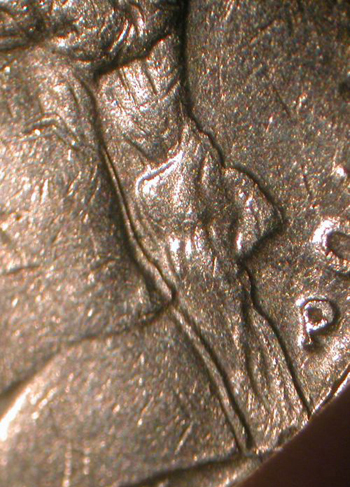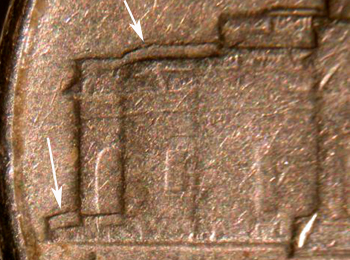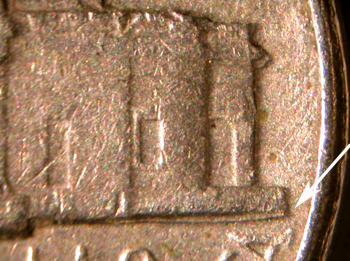|
High-bouncing By |
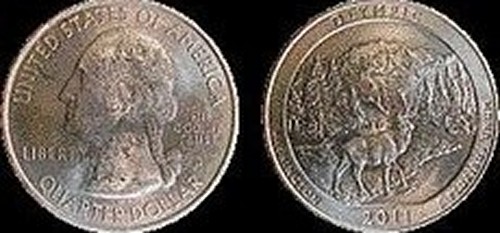 |
|
This 2011-D Olympic Images by Mike Diamond |
|
In 2010, the U.S. Mint The presence of these Machine doubling In some cases, either In other cases, a die Raised and incused While the same die A commemorative Tuel first presented Early opinions I suspected machine The bottom (outer) Forming incused Remember that the A high bounce with a Coin |
|
http://www.coinworld.com/articles/high-bouncing-die-leaves-offset-incuse-machin/
Copyright |
1956 D Lincoln Cent With Partial 5 Digit
PART II. Die Varieties:
Repunched Date:
1956-D Lincoln cent with repunched 5 (controversial)
Definition: A repunched date is produced when a numeral (or several numerals) is punched more than once into a working die, with movement of the punch or die between impacts. On the coin, this results in two overlapping numbers of the same type. A repunched date always involves the same numerals. If different numerals are involved, then we call it an overdate.
Repunched dates should not be confused with doubled dies, re-engraved dates, or misplaced dates.
For U.S. coins, the era of repunched dates ended in 1908. Beginning in 1909, the date was placed on the master hub or the master die. As a result, any claims of repunched dates later than 1908 must be greeted with extreme skepticism.
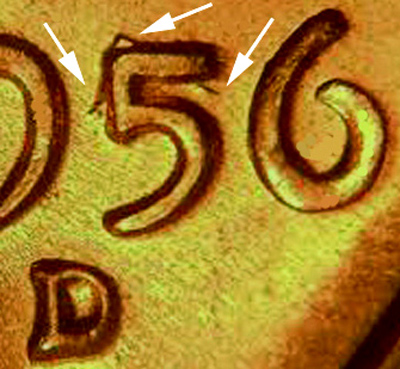
The 1956-D Lincoln cent pictured above is believed by some to have a partially tilted, extra 5 beneath the normal 5. Those who suspect this is a repunched date argue that it is a fouled-up master die was re-used as a working die. While this is possible, it seems unlikely. The horizontal bar seems unaccountably thin, while the vertical bar terminates abruptly and has an unexplained dimple at its base. Skeptics argue that this is a simulacrum produced by two accidental die gouges or die dents.
1957 D With Repunched Date
PART II. Die Varieties:
Repunched Date:
1957-D Lincoln cent with repunched 7 (controversial)
Definition: A repunched date is produced when a numeral (or several numerals) is punched more than once into a working die, with movement of the punch or die between impacts. On the coin, this results in two overlapping numbers of the same type. A repunched date always involves the same numerals. If different numerals are involved, then we call it an overdate.
Repunched dates should not be confused with doubled dies, re-engraved dates, or misplaced dates.
For U.S. coins, the era of repunched dates ended in 1908. Beginning in 1909, the date was placed on the master hub or the master die. As a result, any claims of repunched dates later than 1908 must be greeted with extreme skepticism.
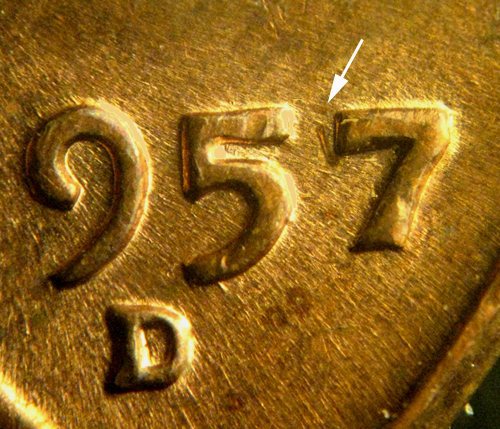
The 1957-D Lincoln cent seen in the image above has a diagonal bar to the left of the top of the 7 digit in the date. Similar in nature to the 1956-D Lincoln cent with “repunched” 5 digit, an argument could be made that a mis- engraved or mis-punched master die was used as a working die. While this is possible, it seems highly unlikely.
A more feasible scenario is that the anomaly is a die dent or gouge.
The photo used is a facsimile.
1958 D Lincoln Cent With Extra 7 Digit In Date
PART II. Die Varieties:
Overdate:
1958/7-D Lincoln cent (debunked)
Definition: An overdate affects a single working die. An overdate is created when one numeral is punched over a different numeral. If the second punch involves the same numeral, we call it a repunched date.
Overdates should not be confused with repunched dates, doubled dies, re-engraved dates, or misplaced dates. They should also not be confused with Class III double dies (design hub doubling). The latter also can result in overlapping, dissimilar numbers, but the process is entirely different. Class III doubled dies that result in overlapping, dissimilar numbers are sometimes called overdates, but this is not correct.
For U.S. coins, the overdate era ended in 1908. Beginning in 1909, the date was placed on the master hub or the master die. As a result, any claims of overdates later than 1908 must be greeted with extreme skepticism.
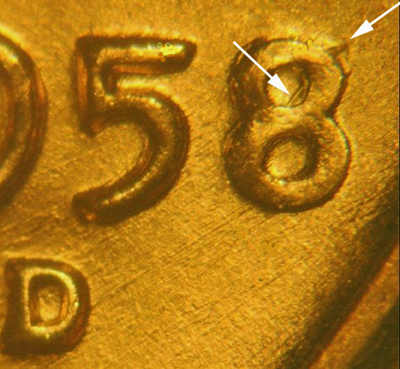
This 1958-D Lincoln cent was once thought to be an overdate. A cluster of die gouges or die dents formed a pattern that resembles a partial 7 beneath the terminal 8.
1988(P) DDO – 003
Part II. Die Varieties:
Doubled Dies:
Class IV (Offset Hub Doubling)
Pictures and an overlay showing 1988 DDO-003. A strong offset and likely tilted ear was hubbed south of the primary ear.
All doubled die illustrations are by Jason Cuvelier.
1872 Dime with 175 Degree Rotation
PART II. Die Varieties:
Doubled Dies
Class I (Rotated Hub Doubling)
1872 Seated Liberty Dime with 175° clockwise rotation
This 1872 Seated Liberty dime has a dramatic reverse doubled die. The first hubbing was almost completely erased
by the second hubbing, which was rotated 175° (clockwise) relative to the first hubbing. However, traces of the first hubbing are still seen on the reverse.
The image below and to the left shows those parts of the first hubbing that are still visible (white arrows). The image to the right is an overlay showing the positions of the two hubbings.
Images are courtesy of Heritage Auctions.
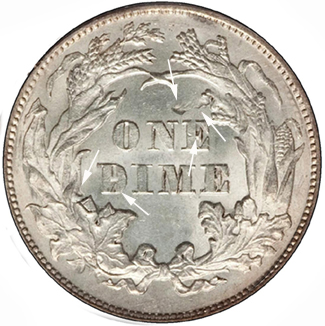
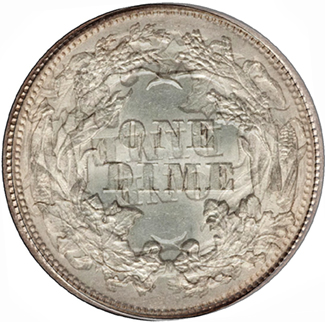
Mule Clash
Part IV. Die Errors:
Clashed Dies:
Mule Clash
Definition: Clash marks from dies that should never have been paired. Mule clashes were, until recently, considered a 19th century phenomenon. Six are known from this century:
- An 1857 Flying Eagle cent that shows a clash between its obverse die and the obverse die of a $20 double eagle gold coin.
- An 1857 Flying Eagle cent that shows a clash between its reverse die and the reverse die of a Seated Liberty quarter dollar.
- An 1857 Flying Eagle cent that shows a clash between its obverse die and the obverse die of a Seated Liberty half dollar.
- An 1857 Seated Liberty quarter dollar that shows a clash between its reverse die and the reverse die of an 1857 Flying Eagle cent.
- An 1864 2 cent coin that shows a clash between its reverse die and the obverse die of an Indian Head cent.
- An 1870 Shield nickel that shows a clash between its obverse die and the obverse die of an Indian Head cent.
It’s widely suspected that all of these mule clashes are the result of mischief by mint employees.
The latest mule clash was discovered in 2018 by Amy Antone in a pile of cents diverted from pocket change. It appears on the reverse face of a 1999 cent. Appearing on the left side, just inside the design rim, is an arc of incuse, mirror-image letters (“oF AMERIC”). The letters are doubled, documenting two die clashes that were slightly offset from each other. The tops of the letters are slightly cut off, indicating that the die responsible for the clash was slightly misaligned toward the left. The peripheral location of the letters indicates that one of the two dies (presumably the hammer die), was tilted.
It’s not clear whether the two dies were actually installed in a press at the time of the clash. It’s also unclear whether this clash was accidental or intentional. This bizarre clash comes from an 11-year time period (1990-2000) that produced over 34 “radical MAD clashes” in Lincoln cents. All of these clashes are weak, tilted, and often drastically misaligned. The conditions that led to these clashes may have contributed to the production of this mule clash.
Rotational Machine Doubling
Part VI. Striking Errors
Machine Doubling
Rotational Machine Doubling
Definition: Machine doubling that occurs when a die rotates after reaching maximum depth of penetration into the coin. It can occur on either face or both faces simultaneously. It can manifest either as push doubling or slide doubling.
This 1996-P nickel shows rotational machine doubling on both faces in the same direction. It conforms to the push doubling subtype, as marginal shelving is well developed. Since the direction and distance of the displacement is the same on both faces, there’s a good chance that it was the newly-struck coin that rotated, instead of the dies. This could have been accomplished by by a rotating collar.
For more information, see this article: http://www.coinworld.com/news/us-coins/2015/07/when-machine-doubling-is-doubled–collectors–clearinghouse.html
Reduction Lathe Doubling
PART II. Die Varieties:
Reduction Lathe Doubling
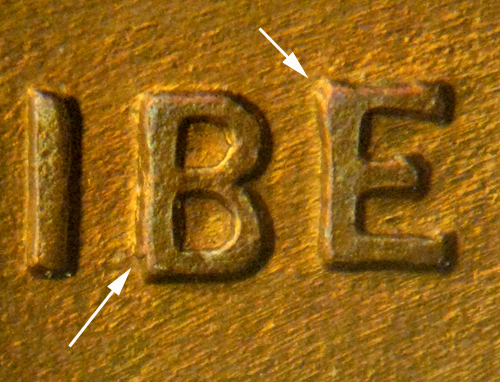
Other Design Elements
PART II: Repunched Design Elements:
Other Design Elements
The image to the right shows a repunched design element, specifically a period between the N and Y. This repunched design element is found on the 1863 Broas Brothers Pie Bakers store card token.
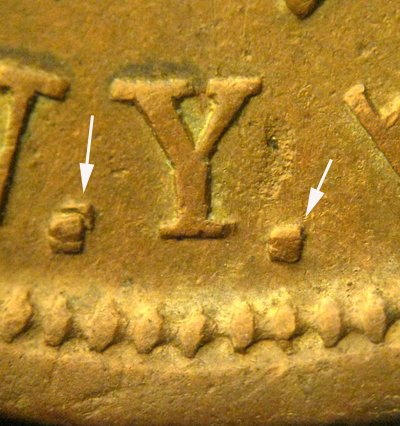
Many older coins show individual design elements repunched into the working die or master die. This action took place after the hubbing of the die. The image to the right shows a repunched star on a 1891, Dos Centavos from Argentina. Notice that the denticles next to the star are not doubled. If the denticles were doubled, this may have indicated that the star was actually on the master hub when the dies were made.
